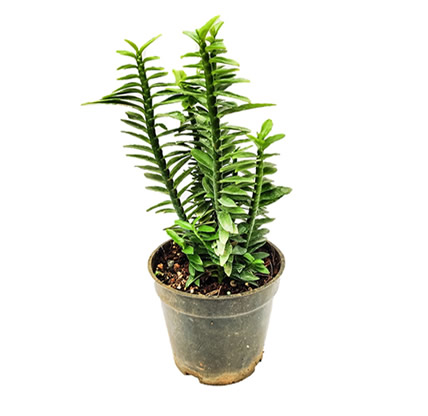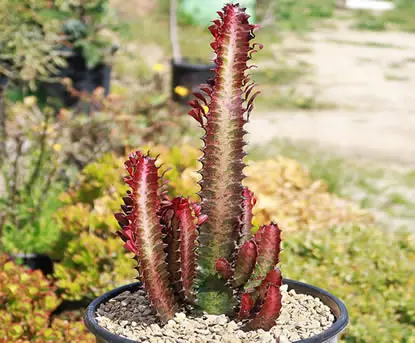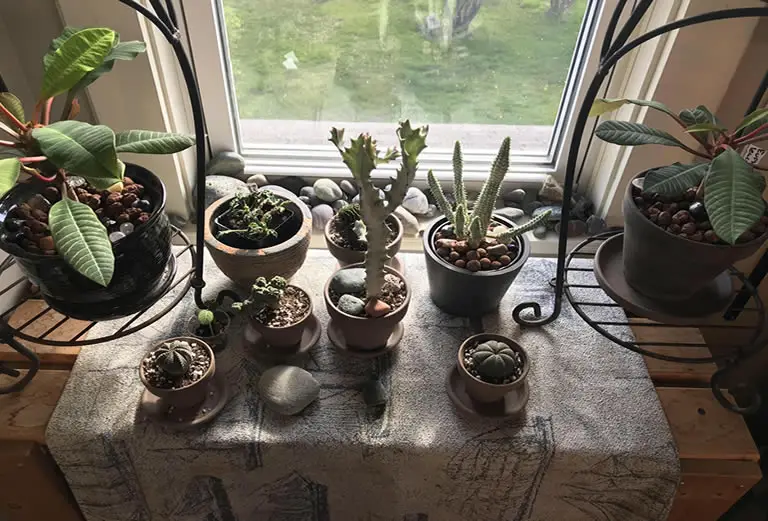The Euphorbia genus is one of the most diverse and visually striking groups in the plant world. From cactus-like succulents to tropical, leafy houseplants, euphorbias are easy to care for, highly adaptable, and bring a bold architectural element to any space.
With over 2,000 known species, Euphorbia plants come in a wide range of shapes, sizes, and colors. While they all share a characteristic milky sap (which can be irritating to skin and toxic if ingested), their care requirements are surprisingly straightforward.
Let’s dive into how to keep your euphorbias thriving indoors and out—and take a look at the most popular varieties worth adding to your collection.
Table of Contents
- Euphorbia
- Light Requirements: Bright Light to Full Sun
- Watering: Drought-Tolerant and Low-Maintenance
- Soil and Potting: Well-Draining and Sandy
- Fertilizer: Feed Sparingly During Active Growth
- Pruning and Maintenance: Minimal Effort
- Best Spot in the Home
- Outdoor Euphorbia Care
- Most Popular Euphorbia Varieties
- Common Problems and Fixes
- Final Thoughts
Euphorbia
Euphorbia is a massive genus within the Euphorbiaceae family, found naturally across Africa, Madagascar, India, and even the Americas.
While many people confuse them with cacti due to their spiny stems and drought tolerance, euphorbias are not true cacti.

What sets Euphorbia apart is its white latex sap, which acts as a defense against pests and herbivores.
Though often grown as succulents, some euphorbias are leafy, tropical species that resemble foliage plants more than succulents.
From sculptural spires to trailing vines, Euphorbia plants offer incredible variety—and all of them respond well to similar care.
Light Requirements: Bright Light to Full Sun
Most euphorbias prefer bright, indirect light and many can handle full sun without issue.
For indoor plants, place them in a south- or west-facing window where they receive at least 4–6 hours of sunlight per day.
Some leafy species, like Euphorbia leuconeura, can adapt to medium light but will grow more slowly.
Outdoor euphorbias appreciate full sun but may need afternoon shade in extremely hot climates to prevent sunburn.
Watering: Drought-Tolerant and Low-Maintenance
Like many succulents, euphorbias are drought-tolerant and prefer to dry out completely between waterings.
Water deeply, then allow the soil to dry thoroughly before watering again.
Overwatering is the most common issue and can quickly lead to rot.
During the winter months, water even less frequently, especially if your plant is dormant.
Always avoid getting water on the crown or base of the plant, as it can lead to fungal problems in many varieties.
Soil and Potting: Well-Draining and Sandy
Euphorbias thrive in fast-draining soil, such as a cactus or succulent mix.
You can also make your own by combining:
-
2 parts cactus mix or sandy loam
-
1 part perlite or pumice
-
Optional: a handful of horticultural charcoal to keep the soil fresh

Use containers with good drainage holes to avoid soggy roots.
Terracotta pots are ideal for their ability to wick away moisture.
Fertilizer: Feed Sparingly During Active Growth
Euphorbias don’t need a lot of fertilizer.
During spring and summer, feed once a month with a balanced liquid succulent fertilizer, such as 10-10-10 like this one, or 5-10-5 like this one, diluted to half strength.
Avoid feeding in fall or winter when the plant is resting.
For leafy varieties, a fertilizer with slightly more nitrogen (e.g. 7-5-5) can promote fuller growth.
Always water before fertilizing to prevent root burn.
Pruning and Maintenance: Minimal Effort
Most euphorbias require very little pruning. Remove dead stems or leaves as needed.
For branching types like Euphorbia trigona, you can trim leggy stems to encourage bushier growth.
Always wear gloves when pruning or repotting, as the sap can irritate skin and eyes.
Consider using healthy stems and cuttings for growing new plants as we outline in our article Euphorbia Propagation: How to Multiply These Striking Succulents with Ease.
Best Spot in the Home
Euphorbia plants are perfect for bright living rooms, sunrooms, and sunny kitchens.
Tall types like Euphorbia ingens or Euphorbia trigona look great in floor pots, while compact or trailing species suit shelves and tabletops.
Leafier types like Euphorbia leuconeura can do well in bright bathrooms or bedrooms with ample filtered light.
Outdoor Euphorbia Care
In USDA zones 9–11, many euphorbias can grow outdoors year-round.
In cooler zones, bring them indoors before the first frost.

Plant them in well-draining soil with full sun exposure and excellent airflow.
Most euphorbias are heat- and drought-tolerant once established, making them great for xeriscaping or dry garden borders.
Be mindful of rain exposure, especially in winter, which can lead to root rot.
Potted euphorbias should be moved to covered patios or porches during storms.
Most Popular Euphorbia Varieties
Here are some of the most loved and easy-to-grow Euphorbia varieties, perfect for indoors or warm-climate gardens:
Euphorbia ingens – Also called “Candelabra Tree,” this large, cactus-like succulent has tall, ribbed branches that grow like a sculpture.
Euphorbia lactea ‘White Ghost’ – A ghostly white and green cultivar with striking branching stems.
Needs very bright light.
Euphorbia ‘Umbrella’ – A term sometimes used to refer to Euphorbia cyathophora or compact leuconeura-like types.
Unique, upright structure.
Euphorbia leuconeura (Madagascar Jewel) – A leafy variety with dark green foliage and white leaf veins.
Self-seeds readily indoors.
Euphorbia tithymaloides (Devil’s Backbone) – A zig-zagging stem succulent with fleshy leaves, often variegated.
Works great in hanging pots.
Euphorbia tjaponica – A rare, compact species with a fat caudex and tiny leaves.
A favorite among collectors.
Euphorbia trigona (African Milk Tree) – Tall, upright stems with small leaves along the ridges.
Very easy to care for and fast-growing.
Euphorbia francoisii – A low-growing succulent with wavy, patterned leaves in striking colors.
Highly collectible.
Euphorbia stenoclada – A spiny, silvery shrub-like euphorbia that resembles coral.
Great for outdoor xeriscapes.
Euphorbia mammillaris – A chunky, columnar cactus-like type that grows in clusters.
Occasionally produces pink blooms.

Euphorbia milii (Crown of Thorns) – A popular flowering euphorbia with thick stems and sharp spines.
Produces long-lasting red, pink, or yellow blooms.
Thrives in bright indoor light.
Common Problems and Fixes
Yellowing leaves or shriveling
Likely due to underwatering or sudden cold exposure. Water thoroughly and move to a warmer, brighter spot.
Soft or mushy stems
A sign of overwatering or root rot. Remove affected parts and repot in dry soil. Reduce watering frequency.
No growth or leaf drop in winter
Most euphorbias go dormant in cooler months. Reduce watering and allow the plant to rest until spring.
White powder or sticky sap
This is often a natural waxy coating or harmless sap, but check for pests like mealybugs just in case.
Pests (mealybugs, spider mites)
Wipe off pests with rubbing alcohol on a cotton swab or spray with neem oil or insecticidal soap.
Final Thoughts
Euphorbias are bold, resilient, and full of character. With minimal care, they reward you with structural beauty, fascinating textures, and endless variety.
Just give them bright light, a well-draining home, and a light hand with water—and you’ll enjoy a thriving, sculptural showpiece for years to come.
Whether you’re after the clean lines of Euphorbia trigona, the ghostly glow of lactea ‘White Ghost’, or the flowering drama of milii, there’s a euphorbia that’s ready to grow with you.

